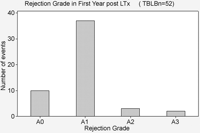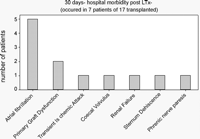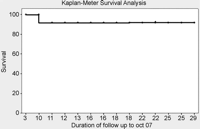-
PDF
- Split View
-
Views
-
Cite
Cite
Waldemar Bartosik, Jim J. Egan, Alan Soo, Kaspar F. Remund, Lars Nölke, James F. McCarthy, Alfred E. Wood, A review of the lung transplantation programme in Ireland 2005–2007, European Journal of Cardio-Thoracic Surgery, Volume 35, Issue 5, May 2009, Pages 807–811, https://doi.org/10.1016/j.ejcts.2008.10.055
Close - Share Icon Share
Abstract
Objective: Lung transplantation is a recognised surgical option for patients with end stage respiratory disease. We present data relating to the initiation of the Irish lung transplant programme in 2005. Methods: Seventeen patients: 7 male and 10 female have undergone lung transplantation. The indications for lung transplantation included COPD (n = 8), idiopathic pulmonary fibrosis (n = 5), bronchiolitis obliterans (n = 2), lymphangioleiomyomatosis (n = 1), and cystic fibrosis (n = 1). Eleven single lungs transplants were completed, while six patients underwent double sequential lung transplantation. The immunosuppression regimen included basiliximab as induction therapy, with steroids, mycophenolate mofetil nd cyclosporine or tacrolimus. Results: The operative mortality was zero. One patient died at 10 months post double lung transplantation secondary to bronchiolitis obliterans. Primary graft dysfunction was observed in two patients who required ventilatory support for 3 and 5 days respectively. Acute cellular rejection was observed in four patients (grade A2 n = 3, grade A3 n = 2). The cumulative 1-year survival was 94.1%, which compares favourably to an international standard of 78%. Conclusions: The initiation of a lung transplant programme in Ireland has been successfully undertaken and initially provided results comparable to established lung transplant programs.
1 Introduction
Lung transplantation (LTx) is currently a well-established, viable option for patients with end stage pulmonary diseases like: chronic obstructive pulmonary diseases (COPD), cystic fibrosis (CF), idiopathic pulmonary fibrosis (IPF) and pulmonary hypertension.
In 2005 the International Society For Heart & Lung Transplantation (ISHLT) reported data relating to 2169 lung transplantation from 110 centres worldwide. Many lung transplant programmes have been active since the late 1980s and early 1990s. Outcome following LTx is influenced by the era, when it was undertaken. In the 1986–1996 period the 1-year survival was 70%. Therefore the initiation of a new programme demanded comparable results to the 1995–2000 with 80% 1-year survival. Traditionally Irish patients were referred to the United Kingdom, where they underwent lung transplantation. Post transplantation follow-up and care was then performed in the Republic of Ireland.The Irish lung transplant programme was initiated in 2001 at the Mater Misericordiae University Hospital in Dublin, and after the planning phase, the first single lung transplantation was completed in May 2005. The unit is the only lung transplant programme in the Republic of Ireland.
2 Material and methods
Patients who underwent lung transplantation in the Mater University Hospital between 2005 and 2007 were reviewed retrospectively.
2.1 Recipient selection
Patients with end stage lung diseases who had failed medical therapy were evaluated. Selection was performed at multidisciplinary conferences, involving the transplant physician, transplant surgeons, anaesthetists, infectious diseases specialist and others. Recipient criteria were based on the international guidelines and survival benefit. The risk of morbidity and mortality was evaluated according to comorbidities and contraindications. Absolute contraindications for listing included: malignancy in the last 2 years, advanced dysfunction of other major organ system, non curable chronic extrapulmonary infection, untreatable psychiatric or psychological condition, substance addiction (tobacco, alcohol or narcotics), and absence of social support. The relative contraindications included: age >65 years, severe obesity or malnutrition, mechanical ventilation and colonisation with highly resistant or virulent bacteria, fungi or mycobacterium. The timing of referral depended on principal diagnosis, clinical, laboratory and functional findings, when patient had less than 50% prediction of 2 years survival.
2.2 Organ selection and retrieval
The Organ Procurement Centre for the Republic of Ireland is based in Beaumont Hospital Dublin attached to the National Renal Transplant Service. Organ selection was performed by the retrieval cardiothoracic team. Donor organs were selected according to predicted total lung capacity (TLC), ABO blood group compatibility in brainstem death individuals. Donor selection criteria included donor age (<55 years old), satisfactory history, a normal chest radiogram, and arterial blood gases of >40 kPa prior to attending the donor hospital. Then ‘on site’ evaluation included bronchoscopy, and manual intra-operative assessment. Pulmonary vein blood gas analysis was performed with FiO2 1.0 and PEEP 5 cmH2O, for a target of pO2 of >40 kPa (>300 mmHg) in each vein [2]. Once the donor lungs were deemed suitable by the lead surgeon, minimal dissection was performed with cannulation of the pulmonary artery (PA) with 6–7 F catheter. Five hundred milligrams methylprednisolone was administrated to the donor. Five hundred micrograms PGE1 was administrated into the donor PA. Heparinisation was achieved with 20,000 units of unfractionated heparin administrated intravenously. The donor heart was arrested with standard technique of crystalloid cardioplegia after cross-clamp, and then the lungs were flushed ante grade into PA with 5.6 l of cold Perfadex solution (Vitrolife, Sweden). After excision of the heart, the trachea was divided and stapled by TA 60 (Ethicon USA) with lungs partially inflated with 100% oxygen. The double lung block was removed and then each lung separated. Additional 1 l of cold Perfadex was used as retrograde flush to each lung. The lung was immersed in 2 l of cold Perfadex in plastic bags and transported on ice to the transplant centre.
2.3 Transplant surgery
Single lung transplantations (SLTx) were performed via posterolateral thoracotomy, double lung transplantation (DLTx) via bilateral anterolateral thoracotomy with a transverse sternotomy (clam shell incision). Cardiopulmonary bypass was ‘on standby’ for all cases. After native lung pneumonectomy, the transplantation procedure was started by bronchial anastomosis with running suture in the membranous part and mattress suture in cartilage part of bronchus with monofilament Prolene 4-0 (Ethicon USA). This procedure was followed by PA and left atrial cuff anastomosis with Prolene 4-0 or 5-0. Methylprednisolone 500 mg was given intravenously prior to reperfusion. Following deairing, the left atrium was declamped with 15 min declamping of PA to prevent lung reperfusion injury. The DLTx were performed as sequential single lung transplant.
2.4 Antibacterial prophylaxis
This was based on a 3-day course of ceftazidime and flucloxacyllin and 7 days course of metronidazole, but tailored according to microbiological results from donors and recipients bronchoscopy specimens.
2.5 Antifungal prophylaxis
Caspofungin was initiated at day 2. In the event of patient being culture positive for aspergillus post LTx, 20 mg nebulised amphotericin was administrated every 6 h.
2.6 CMV prophylaxis
For a primary mismatch D+/R−, the patients received valganciclovir 900 mg once daily and CMV immunoglobulin (100 mg/kg). For reverse mismatch D−/R+ patients, oral valganciclovir was given for 3 months.
2.7 Immunosuppression regimen
Included basiliximab 20 mg at days 0 and 4, as induction therapy and methylprednisolone 125 mg every 8 h for 24 h. Tacrolimus or cyclosporine were commenced when the renal function was judged to be satisfactory. Mycophenolate mofetil was given 1.5 g twice daily after extubation.
2.8 Follow-up
Surveillance flexible bronchoscopy was performed with bronchoalveolar lavage and transbronchial biopsies (TBLB) at 1, 3, 6 and 12 months post LTx. Patients have attended outpatient clinic regularly, with pulmonary function tests performed to detect bronchiolitis obliterans.
3 Results
One hundred and fifty-seven patients were referred for LTx to the Irish lung transplant programme after preliminary screening. Fifty-seven patients were listed for LTx. Seventeen patients (29.8%): 7 male and 10 female underwent LTx. Fourteen patients (24.5%) died waiting for transplantation. In this group nine patients had IPF, three patients had CF, one patient had sarcoidosis and one patient had COPD. Twenty-six patients (45%) remain on the transplant list. Indications for LTx included: COPD (n = 8), idiopathic pulmonary fibrosis (n = 5), bronchiolitis obliterans (n = 2), lymphangioleiomyomatosis (n = 1), and cystic fibrosis (n = 1). Characteristics of transplanted patients are detailed in Table 1 . One self-ventilated patient with bronchiolitis obliterans (BO) due to Sjogren disease was bridged to LTx by interventional lung assist device NovaLung (NovaLung, Germany) for 140 days, and then successfully transplanted. Eleven single lung transplants were completed, six patients underwent double sequential lung transplant. LTx was performed without cardiopulmonary bypass (CPB) in 14 cases (82.35%). The median ischaemic time was 210 min [range 90–300 min]. Patients were extubated on median 39 h post LTx (range 14–120 h). The mean discharge time was 17.3 days [range 11–34]. Fifty-two surveillance TBLB were done in the follow-up period. Acute cellular rejections greater than A2 were observed five times (grade A2 n = 3, grade A3 n = 2) [Fig. 1 ]. One patient had one episode of A3 rejection and one episode of A2 rejection, and then A1. A second patient with A3 had A1 after steroid treatment. Two patients with A2 rejection had A1 rejection subsequently.


The infective complications post LTx occurred in nine patients (Fig. 2 ). The 30-day morbidity occurred in seven patients (Fig. 3 ). There have been no bronchial anastomosis problems. The late morbidity included; poorly differentiated adenocarcinoma of the native lung detected in one patient at 1-year post single LTx. This was successfully treated with pneumonectomy. One patient with COPD 2 years after single LTx needed repeated chest drainages due to recurrent pneumothorax of the native lung, followed by endoscopic lung volume reduction with endobronchial valve insertion. One patient died at 10 months post DLTx secondary to BO. The median follow-up was 19 months [range 1–32]. The cumulative 1-year survival was 94.1%, which is favourable compared to international standards of 78% (Fig. 4 ).



4 Discussion
The first transplantation of the lung was performed by Hardy et al. in 1963 [3]. Over the last two decades lung transplantation has became acceptable therapy for management of end stage lungs disorders with a real survival benefit for lung transplant recipients [1,4–8]. The majority of western European countries provide such a service for their population. The initiation of new transplant programmes remains a challenge, especially when patients have the potential option of travelling to an alternative established centre. The first important step is recipient selection. Life expectancy and quality of life are the main issues and need be considered to for LTx. The goal remains to obtain maximal time from patient native lung, conferring maximum chance of survival with new lungs, and avoiding death on waiting list [1,4,6–8]. Recent data suggest increasing median waiting time to 46 months with mortality up 50% on waiting list [4,5]. The pool of donors is pretty stable but the number of patients awaiting LTx is increasing. In our recipients, median waiting time was 13 months and mortality on the list was 25%. Mechanical ventilation or ECMO were previously available option for terminally ill patients with respiratory failure. Both are associated with worse outcome post lung transplantation. Our initial experience demonstrates that NovaLung can be safely used as bridge to LTx for deteriorating patients with carbon dioxide retention. Emphysema (COPD and Alfa 1-antitrypsin deficiency) is the most common indication for LTx [5,6], occurring in more than 50% of our patients.
Recent international data shows increasing number of patients are being transplanted for IPF. They are prioritised because they have the highest mortality on the waiting list [5–7]. They represented the second most frequent indication for transplantation. Single lung transplantation is still the optimal procedure for COPD and IPF, but the trend for increasing survival following DLTx is encouraging. While DLTx is indicated for a patient with suppurative lung disease, the decision of SLTx or DLTx for a patient with COPD and α1 AT deficiency patients remains controversial. In our institution DLTx was preferred for potential recipients with TLC >250% predicted, purulent secretions with recurrent infections or pulmonary hypertension. The Republic of Ireland has a high donation rate per million population of 22, compared to international data with an average of 12–16 donors per million population but the utilisation is low. In the reported period 248 potential offers of organ donation were received, however most of the donors were not suitable for lung transplantation because of excluding criteria. Sixty percent of donors were declined because of age >55 years old, unacceptable blood gases, abnormal chest X-ray, or chest trauma. Twenty-eight percent of offers were declined following evaluation at the donor site.
Five percent of donors were excluded because of size, blood group, and positive crossmatch and these were offered to UK Transplant. Our retrieval procedure is comparable to procedures described elsewhere [1,9–12]. The CPB (cardio pulmonary bypass) was utilised in three patients (17.6%), which is lower than international reported rates of 30–100% [13,14]. This may contribute to a lower incidence of PGD. In our current practice we always have CPB ‘on standby’. We target CPB to patients with IPF and with pulmonary hypertension. The decision about cannulation is made soon after clamping the pulmonary artery. Right ventricular overload assessed by TOE and haemodynamic instability, hypoxaemia and/or hypercapnia determined use of CPB.
The Washington University Group described the operative techniques in 1989 that have required only minor modification during the last decades [9–12]. According to international data 11–52% patients develop PGD grade 2 or 3 [15,16]. Two patients (12%) developed PGD and required extended ventilation. Both recipients had additional risk factors leading to PGD including CPB, older donor age, longer ischaemic time and secondary pulmonary hypertension.
ISHLT registry reveals that induction therapy is not standard practice and was given to 38–46% of recipients [5,17,18]. All our patients received induction therapy with basiliximab and no adverse reaction was observed. Maintenance medication is based on tacrolimus or cyclosporine with mycophenolic mofetil and steroids, which is comparable to international standards. Irrespective of the type of immunosuppression therapy, 40–50% of patients require treatment for acute rejection during the first year post LTx over the world [5,19,20]. Our data showed four patients (23.5%) had A2 rejection or greater in that period.
Graft failure and non-CMV infections are the principal fatal complications in the first 30 days post LTx. Pseudomonas aeruginosa and other gram-negative bacteria were the leading pathogens after LTx, which is comparable to other studies [21,22]. The incidence of Aspergillus post LTx is between 2.2% to 20%, and usually occurs 1–6 months post LTx according to international data [23].
Clinical manifestation may be tracheobronchitis, bronchial anastomosis infection, invasive pulmonary aspergillosis or disseminated invasive aspergillosis. Aerosolised amphotericin B and itraconazole or voriconazole are the most frequently used prophylactic drugs in lung transplant recipients. In ours patients, infective complications occurred in nine patients (52.9%) and four patients (23%) had Aspergillus colonisation.
Bronchiolitis obliterans syndrome is defined as an irreversible decline in forced expiratory volume in 1 s (FEV1) at least 20% of the individual baseline volume. BOS is the most common complication after 1 year post LTx, and affects 43% recipients by 5-year follow-up and is the leading cause of late mortality. In our study, one patient died 10 months post DLTx due to BOS. This high-risk patient with diabetes mellitus, obesity, and preoperative borderline renal function had several complications post LTx including bacterial pneumonia, CMV pneumonia and sternum dehiscence. Reduction of episodes of acute rejection and post transplant infections might result in lower incidence of BOS [5,17–20].
Immunosuppression treatment after transplantation has been associated with higher risk of malignances compared with the general population. In the first 5 years post LTx 16% of the recipients had some type of malignancy, and by 10 years 32% of patients developed a malignancy [5,24,25]. One year following SLTx we diagnosed native lung cancer in 1 ex-smoker patient with COPD. Smoking history was found to be strongly associated with the development of non-small cell lung carcinoma and DLTx has be referred as a procedure of choice for a COPD patient with long smoking history. However this is not generally an accepted indication for DLTx.
In our study 1-year survival is 94.1%. Preliminary analysis shows, that our 2-year survival follows similar trend, favourably compares to international standards [5]. The limitation of this study was retrospective, descriptive, small group of transplanted patients, and short follow-up.
In summary, the initiation of a new transplant programme can be successfully undertaken and provide results comparable to established lung transplant programmes. We achieved our first target: quality, when benchmarked against the ISHLT data. The second target of increased quantity is dependent on organ donation and utilisation of available donors. This may be achieved by improved management of potential donors in critical care units.
Presented at the 16th European Conference on General Thoracic Surgery, Bologna, Italy, June 8–11, 2008.
References
- mycophenolate mofetil
- chronic obstructive airway disease
- lung transplantation
- graft rejection, cellular, acute
- lung
- basiliximab
- bilateral lung transplantation
- bronchiolitis obliterans
- cystic fibrosis
- ireland
- neoadjuvant therapy
- respiration disorders
- respiratory tract diseases
- steroids
- surgical procedures, operative
- idiopathic pulmonary fibrosis
- therapeutic immunosuppression
- cyclosporine
- tacrolimus
- transplantation
- lymphangioleiomyomatosis
- surgical mortality
- primary graft dysfunction
- heart sound a2




